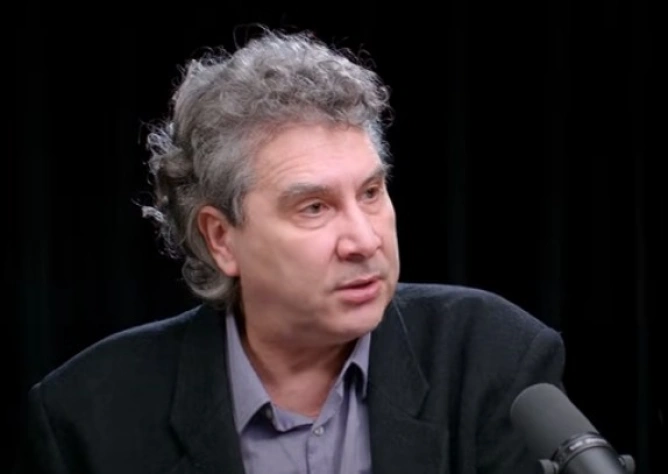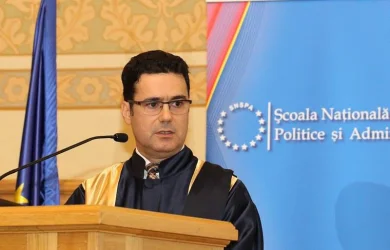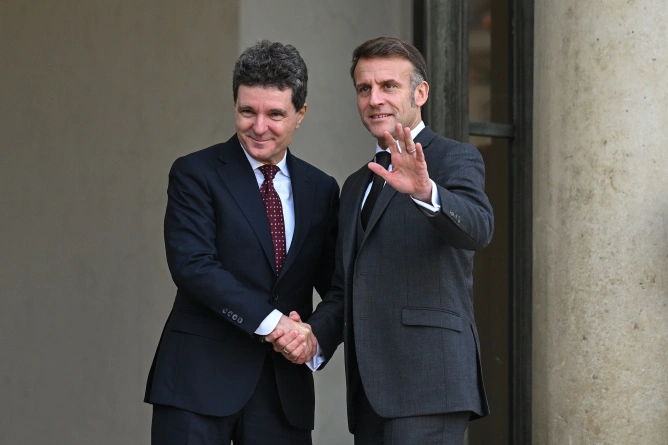10 September 08:49

Opinions
Foto centrulpolitic.ro
"France is decapitating Vidraru. Romania's resources stolen for foreign profit." On this occasion, an online disinformation campaign has begun. Some internet users have written that the French are draining the water to get their hands on the gold that lies at the bottom of the lake. In another clip, also created with the help of artificial intelligence, it is shown that the Vidraru dam has been demolished. The person who posted the video writes that the water is wreaking havoc. The purpose of the post is to instill fear among the people. Meanwhile, on TikTok, thousands of videos have appeared in which anonymous users confidently proclaim: "From September we are entering a war for Ukraine." In another register, a pseudo-academic conference about Covid-19 gathers "experts" discussing vaccines as biological weapons, nanotechnology as a tool of cognitive warfare, and artificial intelligence as an invasion of the human being.
At first glance, these narratives seem disparate and absurd. In reality, they are part of a sophisticated architecture of disinformation, which aims not only to spread lies but to build a parallel, psychologically coherent reality, in which democracy is delegitimized, institutions are corrupt or captive, and salvation can only come from a radical, anti-system leader. This alternative reality is not a product of coincidence. It is based on a narrative triad – historical-mythical, conspiratorial-political, and emotional-catastrophic – which, once internalized by the public, transforms social perception and becomes resistant to facts and arguments.
The first link of the triad is the mythologized past. In Romania, this type of discourse recovers themes such as "Romania destroyed by traitors," "Dacians as a pure and free people," or nostalgia for communism transformed, retroactively, into an era of "national dignity." These narratives respond to a psychological need for lost prestige and stability. They provide a sense of identity and security by projecting into the past, but transform the present into a ground of resentment. Moreover, historical myths are used as a vehicle for political mobilization, as they confer moral legitimacy to radicals who present themselves as continuators of a "national mission." In this way, the past becomes not only a psychological refuge but also an ideological weapon.
The second component represents conspiracies about elites. If the past was glorious and the present is degraded, then there must be culprits. Messages about Brussels dictating everything, NATO sacrificing Romania, or NGOs and globalists undermining sovereignty provide a simple and attractive explanation. In the 2024 presidential campaign, these narratives were amplified by TikTok algorithms and networks of fake or coordinated accounts, which propelled a fascist outsider into a viable candidate role. The causal certainty that conspiracies offer satisfies a fundamental need: that of understanding "who is to blame." Thus, hatred is channeled towards democratic institutions and Western partners.
The third link is the emotional crisis. Alarmist messages about imminent war, about looted resources, about criminal vaccines trigger fear, anger, and guilt. This emotional dimension closes access to critical thinking and transforms the individual into an impulsive receiver, prone to rapid and radical reactions. The emotional crisis acts as a catalyst: it not only reactivates collective traumas but makes rational deliberation impossible and compromises society's ability to distinguish between real and imaginary. This is also the reason why, after two massive hybrid attacks – one during the pandemic and the other during the November 2024 elections – Romanian authorities remain unaware, underestimating the magnitude of the danger. This negligence is compounded by the complicity of some anti-national and pro-Russian parties and structures, which turn disinformation into a political weapon for immediate gain. In their quest for power, these forces do not hesitate to sacrifice state stability and trample on democratic sovereignty, won with blood on the streets of Romania in December 1989.
Together, the three narratives produce an alternative world. Romania appears as a country betrayed by elites, subjugated by external forces, on the brink of collapse and war, where the only solution is a messianic leader who will lead Romania "with an iron fist." This triad operates not only at the level of perception but generates a process of informational radicalization. Passive exposure to such content gradually transforms into emotional adherence, then into active engagement, digital militancy, and, ultimately, offline mobilization. Romania has already seen how Telegram and TikTok networks have become hubs for coordinating algorithmic activism, comment campaigns, and manipulated protests.
Worse, the attacks are no longer just verbal. Last week, online-instigated individuals brutally attacked foreign workers on the street, signaling the transition from digital rhetoric to physical violence. Once this type of behavior is validated, the target will be easily expanded: from migrants to "globalists," intellectuals, journalists, or minorities, fueling an atmosphere that dangerously recalls Romania in the 1990s, when ideological violence became a norm in public space.
This escalation shows that defensive methods are no longer sufficient. Fact-checking, platform regulation, or media literacy programs are necessary but remain a "whack-a-mole" game: for every falsehood debunked, ten more appear. In the absence of an offensive strategy, the initiative remains in the hands of those who manipulate. Democratic states, including Romania, must understand that the hybrid war cannot be won solely through delayed and fragmented institutional reactions.
Romania needs a national rapid response center for hybrid warfare, which combines expertise in cybersecurity, strategic communication, intelligence, and civil society. Such a hub would have the task not only to counter disinformation campaigns but also to take the initiative: to identify vulnerabilities in advance, to publicly expose influence networks, and to build positive narratives anchored in reality. Preventing violent radicalization and defending democracy cannot rely solely on defensive reactions. Only through an offensive strategy, capable of dismantling hostile operations before they become viral and create social rifts, can Romania avoid slipping into a spiral of instability that would play into the hands of its adversaries.
The stakes are very high. If not stopped, the disinformation triad will continue to transform Romanian society into parallel communities, separated from reality and refractive to truth. And at the moment when a critical mass of citizens lives in an alternative world, we are no longer talking just about the fragility of institutions, but about the fragility of democracy itself. Romania can no longer afford the luxury of waiting. It is time to move from defense to offense and to build its own rapid response tools before the alternative reality becomes the dominant reality.
At first glance, these narratives seem disparate and absurd. In reality, they are part of a sophisticated architecture of disinformation, which aims not only to spread lies but to build a parallel, psychologically coherent reality, in which democracy is delegitimized, institutions are corrupt or captive, and salvation can only come from a radical, anti-system leader. This alternative reality is not a product of coincidence. It is based on a narrative triad – historical-mythical, conspiratorial-political, and emotional-catastrophic – which, once internalized by the public, transforms social perception and becomes resistant to facts and arguments.
The first link of the triad is the mythologized past. In Romania, this type of discourse recovers themes such as "Romania destroyed by traitors," "Dacians as a pure and free people," or nostalgia for communism transformed, retroactively, into an era of "national dignity." These narratives respond to a psychological need for lost prestige and stability. They provide a sense of identity and security by projecting into the past, but transform the present into a ground of resentment. Moreover, historical myths are used as a vehicle for political mobilization, as they confer moral legitimacy to radicals who present themselves as continuators of a "national mission." In this way, the past becomes not only a psychological refuge but also an ideological weapon.
The second component represents conspiracies about elites. If the past was glorious and the present is degraded, then there must be culprits. Messages about Brussels dictating everything, NATO sacrificing Romania, or NGOs and globalists undermining sovereignty provide a simple and attractive explanation. In the 2024 presidential campaign, these narratives were amplified by TikTok algorithms and networks of fake or coordinated accounts, which propelled a fascist outsider into a viable candidate role. The causal certainty that conspiracies offer satisfies a fundamental need: that of understanding "who is to blame." Thus, hatred is channeled towards democratic institutions and Western partners.
The third link is the emotional crisis. Alarmist messages about imminent war, about looted resources, about criminal vaccines trigger fear, anger, and guilt. This emotional dimension closes access to critical thinking and transforms the individual into an impulsive receiver, prone to rapid and radical reactions. The emotional crisis acts as a catalyst: it not only reactivates collective traumas but makes rational deliberation impossible and compromises society's ability to distinguish between real and imaginary. This is also the reason why, after two massive hybrid attacks – one during the pandemic and the other during the November 2024 elections – Romanian authorities remain unaware, underestimating the magnitude of the danger. This negligence is compounded by the complicity of some anti-national and pro-Russian parties and structures, which turn disinformation into a political weapon for immediate gain. In their quest for power, these forces do not hesitate to sacrifice state stability and trample on democratic sovereignty, won with blood on the streets of Romania in December 1989.
Together, the three narratives produce an alternative world. Romania appears as a country betrayed by elites, subjugated by external forces, on the brink of collapse and war, where the only solution is a messianic leader who will lead Romania "with an iron fist." This triad operates not only at the level of perception but generates a process of informational radicalization. Passive exposure to such content gradually transforms into emotional adherence, then into active engagement, digital militancy, and, ultimately, offline mobilization. Romania has already seen how Telegram and TikTok networks have become hubs for coordinating algorithmic activism, comment campaigns, and manipulated protests.
Worse, the attacks are no longer just verbal. Last week, online-instigated individuals brutally attacked foreign workers on the street, signaling the transition from digital rhetoric to physical violence. Once this type of behavior is validated, the target will be easily expanded: from migrants to "globalists," intellectuals, journalists, or minorities, fueling an atmosphere that dangerously recalls Romania in the 1990s, when ideological violence became a norm in public space.
This escalation shows that defensive methods are no longer sufficient. Fact-checking, platform regulation, or media literacy programs are necessary but remain a "whack-a-mole" game: for every falsehood debunked, ten more appear. In the absence of an offensive strategy, the initiative remains in the hands of those who manipulate. Democratic states, including Romania, must understand that the hybrid war cannot be won solely through delayed and fragmented institutional reactions.
Romania needs a national rapid response center for hybrid warfare, which combines expertise in cybersecurity, strategic communication, intelligence, and civil society. Such a hub would have the task not only to counter disinformation campaigns but also to take the initiative: to identify vulnerabilities in advance, to publicly expose influence networks, and to build positive narratives anchored in reality. Preventing violent radicalization and defending democracy cannot rely solely on defensive reactions. Only through an offensive strategy, capable of dismantling hostile operations before they become viral and create social rifts, can Romania avoid slipping into a spiral of instability that would play into the hands of its adversaries.
The stakes are very high. If not stopped, the disinformation triad will continue to transform Romanian society into parallel communities, separated from reality and refractive to truth. And at the moment when a critical mass of citizens lives in an alternative world, we are no longer talking just about the fragility of institutions, but about the fragility of democracy itself. Romania can no longer afford the luxury of waiting. It is time to move from defense to offense and to build its own rapid response tools before the alternative reality becomes the dominant reality.
























